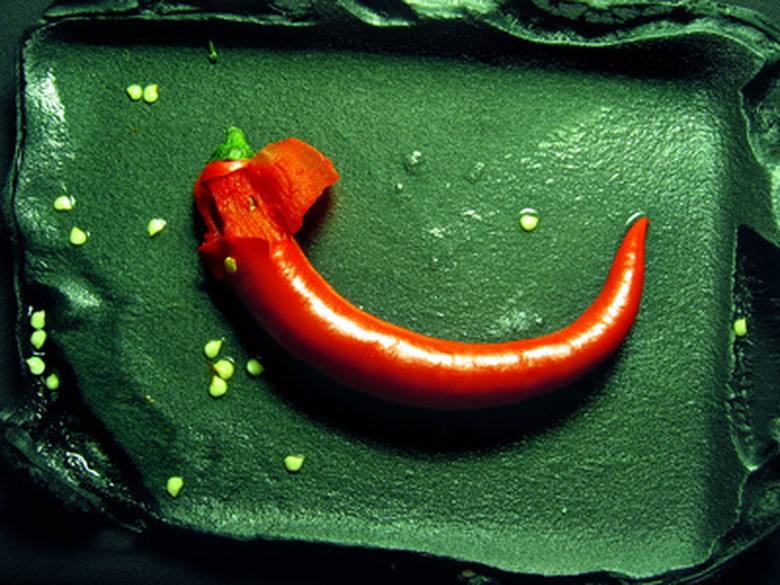How To Grow Trinidad Scorpion Peppers
The Trinidad scorpion pepper (Solanaceae capsicum chinense Trinidad scorpion) is an annual plant known for producing extremely spicy peppers. These peppers are so hot, in fact, that Guinness World Records named the Trinidad scorpion "Butch T" cultivar (Solonaceae capsicum chinense Trinidad scorpion "Butch T") the hottest chili in the world in March 2011. This makes the Trinidad scorpion the hottest pepper you can grow in your own garden, and you may have to grow it there if you are brave enough to eat them. The pepper is, as its name suggests, native to the Caribbean island of Trinidad and is difficult to find in grocery stores. Even seedlings can be tough to find in local nurseries, and you will likely have to grow this pepper from seeds ordered online.
Step 1
Step 1
Fill a tray with seed starting soil mix and plant the pepper seeds 1/4 inch deep in the tray eight to 10 weeks before the last expected frost. Water the seeds with hot water immediately after planting.
- The Trinidad scorpion pepper (Solanaceae capsicum chinense Trinidad scorpion) is an annual plant known for producing extremely spicy peppers.
- The pepper is, as its name suggests, native to the Caribbean island of Trinidad and is difficult to find in grocery stores.
Step 2
Step 2
Place the uncovered tray in an area with good air circulation and a temperature of around 85 degrees Fahrenheit. At this stage, the temperature is more crucial than light, so you can put the tray in a dark area if the correct temperature is maintained. Keep the soil around the seeds and young plants moist, but never wet or soggy.
Step 3
Step 3
Move the seedlings to a place where they will receive eight to 10 hours of sunlight a day once they have sprouted. The plants will do well at temperatures as low as 70 degrees Fahrenheit after sprouting.
Step 4
Step 4
Plant the seedlings in the garden two week after the last frost has occurred and the plants have grown about 12 inches high. The planting bed should be in full sun where temperatures stay between 60 and 95 degrees. Provide the peppers with afternoon shade in hotter areas of the garden. Space the plants 1 1/2 to 2 feet apart in the planting bed.
- Place the uncovered tray in an area with good air circulation and a temperature of around 85 degrees Fahrenheit.
- Plant the seedlings in the garden two week after the last frost has occurred and the plants have grown about 12 inches high.
Step 5
Step 5
Sprinkle a granular 5-10-10 fertilizer beside the rows of pepper plants when they have blossomed. This will provide enough nutrition to fertilize your pepper plants for the entire growing season.
Step 6
Step 6
Water the peppers in the morning or early evening with a watering can or sprinkler system to simulate rainfall. Keep the soil around the peppers damp but do not allow it to get soggy — peppers will not tolerate wet feet. Ideally, the peppers should receive 3 quarts of water twice a week, either through irrigation or rainfall.
Step 7
Step 7
Harvest the peppers about 90 to 120 days after planting in the garden, when they have attained a rich red color. Young peppers will start green, turn yellow and then change to red when ready to be picked. Pick your peppers about two weeks earlier if you want a slightly milder flavor. Wear gloves when harvesting the peppers, because the oil from the Trinidad scorpion and other hot peppers can irritate your skin.
- Sprinkle a granular 5-10-10 fertilizer beside the rows of pepper plants when they have blossomed.
- Water the peppers in the morning or early evening with a watering can or sprinkler system to simulate rainfall.
Tip
If you water the peppers in the evening, do so early enough to allow the leaves of the plant to dry before nightfall.
Tip
For best results, water your peppers with spring water, rainwater or other nonchlorinated water sources.
Warning
Plant Trinidad scorpion peppers well away from sidewalks, patios and other areas where children and pets may come in contact with them. This is an extremely potent pepper and the oil from the plant can cause skin irritation and burning.
Things Needed
- Seed starting tray (without cover)
- Seed starting soil mix
- Trowel
- 5-10-10 granular fertilizer
- Sprinkler or watering can
- Gloves
References
- Sunset Western Garden Book; Editors of Sunset Magazine
- Reimer Seeds: Hot Pepper Growing Tips
- Smart Gardener: Peppers: Trinidad Scorpion
- University of Florida: Hot Peppers
- Pepperheads: Grow Trinidad Scorpion Peppers
- Burpee: Growing Peppers
- Guinness World Records: Trinidad Scorpion "Butch T"
